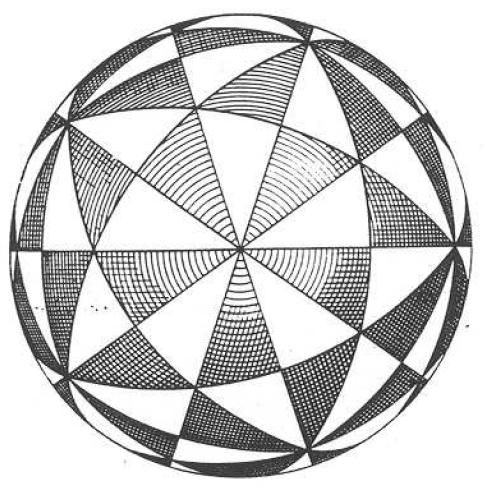Several months ago I saw this image and wondered if the plot shown in the original probelm was actually the solution to the stated PDE. In addition to being a fun problem it’s also a good excuse to play with some plots in python.
Problem
Solve
\[\begin{align} \left(\frac{\partial^2}{\partial x^2}+3\frac{\partial^2}{\partial x\partial y}-4\frac{\partial^2}{\partial y^2}\right)f(x,\,y)=xy\tag{1}\end{align}\]subject to the conditions
\[f(x,\,x)=\sin(x)\]and
\[\frac{\partial}{\partial x}f(x,\,y)\bigg\vert_{y=x}=0.\]Solution
First we note this is a hyperbolic partial differential equation with
\[\lambda_1=1,\,\lambda_2=-\frac{1}{4}.\]In order to find a solution we start by making a change of variables $u=x+\lambda_1y$ and $v=x+\lambda_2y$. Let $h(u,\,v)=f(x+\lambda_1y,\,x+\lambda_2y)$, differentiating then gives the equations
\[\frac{\partial^2}{\partial x^2}f(x,\,y)=\left(\frac{\partial^2}{\partial u^2}+2\frac{\partial^2}{\partial u\partial v}+\frac{\partial^2}{\partial v^2}\right)h(u,\,v),\] \[\frac{\partial^2}{\partial x\partial y}f(x,\,y)=\left(\frac{\partial^2}{\partial u^2}+\frac{3}{4}\frac{\partial^2}{\partial u\partial v}-\frac{1}{4}\frac{\partial^2}{\partial v^2}\right)h(u,\,v),\] \[\frac{\partial^2}{\partial y^2}f(x,\,y)=\left(\frac{\partial^2}{\partial u^2}-\frac{1}{2}\frac{\partial^2}{\partial u\partial v}+\frac{1}{16}\frac{\partial^2}{\partial v^2}\right)h(u,\,v).\]Substituting these into $(1)$ (and noting that $x=4(v+u/4)/5,\,y=4(u-v)/5$) causes something nice to happen; the original PDE reduces to
\[\frac{\partial^2}{\partial u\partial v}h(u,\,v)=\frac{16}{625}\left(u^2+3uv-4v^2\right).\]Now we may integrate this to get
\[\begin{align} h(u,\,v)=\frac{16}{625}\left(\frac{u^3v}{3}+\frac{3u^2v^2}{4}-\frac{4uv^3}{3}\right)+s(u)+t(v).\tag{2}\end{align}\]Both of the initial conditions give
\[\frac{41x^4}{625}+s(2x)+t(3x/4)=\sin(x)\]and
\[\frac{326x^3}{1875}+s'(2x)+t'(3x/4)=0.\]Integrating this second equation results in
\[\frac{163x^4}{1250}+\frac{s(2x)}{2}+\frac{4t(3x/4)}{3}=C.\]We may then solve for $s(2x)$ and $t(3x/4)$,
\[s(2x)=\frac{161x^4}{3125}-\frac{6C}{5}+\frac{8\sin(x)}{5}\]and
\[t(3x/4)=-\frac{366x^4}{3125}+\frac{6C}{5}-\frac{3\sin(x)}{5}.\]Substituting these into $(2)$ and changing back to $x,\,y$ yields
\[f(x,\,y) = -\frac{100801x^4}{270000}+\frac{28807x^3y}{67500}-\frac{719x^2y^2}{9000}+\frac{371y^4}{270000}-\frac{3}{5}\sin\left(\frac{4x-y}{3}\right)+\frac{8}{5}\sin\left(\frac{x+y}{2}\right).\]So, back to the initial question, does this function look like the plot in the original image?
1
2
3
4
5
6
7
8
9
10
11
12
13
14
15
16
17
18
19
20
21
import numpy as np
import matplotlib.pyplot as plt
from mpl_toolkits.mplot3d import Axes3D
def f(x, y):
return (-100801*x**4)/270000+(28807*(x**3)*y)/67500-(719*(x**2)*y**2)/9000+(371*y**4)/270000-(3/5)*np.sin((4*x-y)/3)+(8/5)*np.sin((x+y)/2)
x = np.linspace(-100, 100, 1000)
y = np.linspace(-100, 100, 1000)
X, Y = np.meshgrid(x, y)
fig = plt.figure()
ax = fig.add_subplot(111, projection='3d')
ax.plot_surface(X, Y, f(X,Y), cmap='viridis')
ax.set_title("$f(x,\,y)$")
ax.set_xlabel('X')
ax.set_ylabel('Y')
ax.set_zlabel('Z')
plt.show()
After some generous toying with the scaling of the axes, I say no.

